

iWorker%20-%20Infographic_EU.pdf. One Third of European Businesses to Introduce Wearable Technology to the Workplace in 2015. However, over three quarters of businesses in the UK, France and Germany admit they have no policy for managing the impact of wearables joining the network LONDON, UK – December 11 2014 – Ipswitch™ today announced the results of a European online survey of IT professionals* to determine the readiness of businesses for wearable technology in 2015.
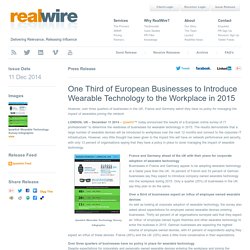
The results demonstrate that a large number of wearable devices will be introduced to workplaces over the next 12 months and connect to the corporate IT infrastructure. Driving employee productivity and wellbeing in a future of ‘everywhere ergonomic’ technology. Driving employee productivity and wellbeing in a future of ‘everywhere ergonomic’ technology By Carsten Bruhn, Executive Vice President, Commercial, Ricoh Europe Ricoh Europe, London, 26 January 2015 – It’s difficult to avoid adverts or news stories about the amazing technological feats the modern ‘intelligent car’ can perform.
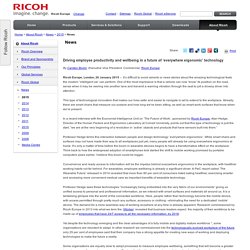
One of the most impressive is that a vehicle can now ‘know’ its position on the road, sense when it may be veering into another lane and transmit a warning vibration through the seat to jolt a drowsy driver into attention. A Periodic Table Of Wearable Technology. There is a surprisingly rich ecosystem of devices, a plethora of uses, and importantly, a wealth (both in quantity and value) of markets that are investigating the value of wearables in the enterprise.
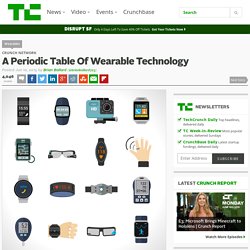
To capture the different hardware types, uses, and common capabilities we’ve seen applied to wearables, our Periodic Table of Wearable Technology groups together the major elements of wearables to outline what executives need to know before deploying these devices to their workforce. This is probably an appropriate time to note that there are no “radioactive elements” when it comes to wearables. Explosive situations only occur when wearable technology is abused or common sense is checked at the door. Source and complete table here. Five Ways to Get Consumers to Love Wearables - Businessweek. Wearables are the future.

We may all be flashing some type of wearable device in 2020, but most of us don’t own one today. In fact, only one in five owns a wearable device now, according to a new report from PricewaterhouseCoopers. The survey of 1,000 consumers, “wearable technology influencers,” and business executives gives some recommendations for how the products might go from promising to truly useful items in our daily attire. The report defines wearable technology as “clothing and accessories that incorporate computer and advanced electronic technologies,” including smartwatches and glasses, action cameras, and fitness trackers. Here are five of the report’s prescriptions for wearable tech. How Wearable Technology Will Impact Digital Marketing. You may have heard of the term ‘wearable technology.’

It’s something we briefly mentioned in our previous blog post, ‘Things to Come For Digital Marketing in 2015.’ CES 2015 Report on Wearables. At the beginning of January, I attended CES 2015 in Las Vegas to see what patterns were emerging in consumer technology, specifically in the arenas of health, fitness, wellness, and and consumer medical.

It’s taken a month or so to digest what I saw and look for the larger patterns to emerge. Some thoughts about what I learned: LinkedIn. Tracking the trends in. 3 weeks ago at the Wearable Technologies Conference in San Francisco we did not hear about wearables.
Instead we heard everything about wristables, hearables, bendables, energizables, sensibles, wrappables. What a fresh change in not only linguistics and vocabulary, but also shows that the industry is starting to redefine itself in a more sophisticated manner. At WT we make it our business to keep up with the latest in the industry, with criteria of course. Some areas of the overall market are still highly volatile and all supporting companies as ourselves as a neutral platform need to assess whether new developments are of added value, without selling short on any new technology. That is not an easy task and many companies in our network ask us for advice on how to select wearables worth the while. Forget smartwatches - smartclothes are the future, analysts say. The popularity of fitness-tracking wristbands will wane in the next 12 months, according to market analysts, as consumers opt instead for more versatile smartwatches and new smartclothing.
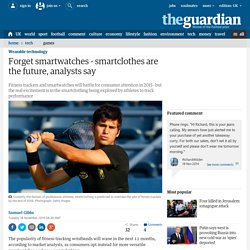
Currently the domain of professional athletes, smart clothing will overtake the sale of fitness trackers by the end of 2016 as consumer products become available. Rapid growth in wearable electronics and e-textiles is projected. An overview of wearables markets shows the variety of products available and in development.

Wearable technology is the term rocketing to the stars on Google Trends but it is almost entirely about wearable electronics today. This is a large ($14 billion) business for humans and nearly $1 billion for animals. Têxteis com quadrimestre de luxo. Market sizing: How big is the #wearables market today? « WearableTechWatch. Market sizing: How big is the #wearables market today?
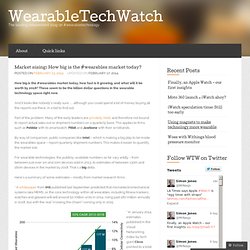
Posted on Updated on How big is the #wearables market today, how fast is it growing, and what will it be worth by 2018? These seem to be the billion dollar questions in the wearable technology space right now. And it looks like nobody’s really sure … although you could spend a lot of money buying all the reports out there, in a bid to find out. Part of the problem: Many of the early leaders are privately-held, and therefore not bound to report actual sales out or shipment numbers on a quarterly basis. By way of comparison, public companies like Intel – which is making a big play to be inside the wearables space – report quarterly shipment numbers.
Não está disponível. With 171 million wearable devices forecast to be shipped in 2016, the wearable technology market is projected to create significant opportunities for a range of suppliers in a number of product categories. This information is based on a new report from IMS Research (recently acquired by IHS (NYSE: IHS)), an official research partner of Wearable Technologies.
Suppliers are successfully establishing and expanding the number of essential user cases for wearable devices. The main factors include the size of the device in question, non-invasiveness, the ability to measure multiple parameters and to provide automated feedback for improved user behaviour. Moreover wearable devices must be increasingly multi-tasking in order to be considered significantly useful. This means integrating multiple sensors and transducers, supporting different connectivity profiles and reducing power consumption, thus creating opportunities for both brand manufacturers and component suppliers alike. Figure 1. Wearable Electronics Market and Technology Analysis (2013 – 2018): By Components (Sensors, Battery, Display, Networking); Applications (Consumer, Healthcare, Enterprise); Products (Smart -Textiles, Glasses, Watches);e-Materials & Geography. Wearable computers are small electronic devices worn by the user, which enable mobile computing and wireless networking.
The term “Wearable technology” refers to any electronic device or product which can be worn by a person to integrate computing in his daily activity or work and use technology to avail advanced features & characteristics. Concerted efforts from industry and academia for over two decades have resulted into host of sophisticated products and devices being launched in the market.
The potential of the industry can be gauged by the fact that both - the big and established players and small start-ups have up their ante in wearable technology market. The market was worth $2.7 billion in revenue in 2012 and is expected to reach $8.3 billion in 2018, growing at an estimated CAGR of 17.71% from 2013 to 2018. In terms of product, wrist-wear accounted for the largest market revenue at $876.70 million, while neck-wear enjoyed the least market share, all as of 2012. CHART: Wearable Computing Market Estimates Are All Over The Place. Wearable Electronics (Smart Textile) Market By Components, Applications, Products & E-Materials -2018. Global Smart Textiles Industry Trends And Market Segment Forecasts To 2020 - Worldwide Smart Textiles Market, Outlook, Size, Share, Growth Prospects, Key Opportunities, Dynamics, Analysis, Sales, Company Profiles, Smart Textiles Report - Grand View Resear. Industry Insights Global smart textile market size was USD 350.3 million in 2013. Decreasing manufacturing costs of electronic components as well as fabrics along with miniaturization of electronics is expected to drive the smart fabric market over the forecast period.
Rising popularity of sophisticated gadgets with varied technologically advanced functions is anticipated to drive market demand. The wearable-computing market: a global analysis. 1Executive Summary During a Formula 1 race a driver experiences wrenching forces of more than 4.5G. His heart rate may exceed 180 beats per minute and his blood pressure could rise by half. What will sports look like in the future? A TED2014 discussion. If you’ve ever seen grainy old sports footage—for example, a boxing match from the late 1800s, a Princeton/Yale game from 1903, or Babe Ruth’s famous home run from 1932—you probably noticed something: how different the game looks, compared to its modern counterpart. The equipment looks too clunky, the uniforms impossibly baggy. The Role of Big Data in Personalizing the Healthcare Experience: Mobile. This article was written with Ellen M. Printed, Organic & Flexible Electronics: Forecasts, Players & Opportunities 2013-2023: IDTechEx.
Why the wearable explosion is driving tech and fashion convergence. Free Publications. Wearable Technology - The Next Mobility Market is Booming! 2014 Trend Reports + TREND HUNTER PRO Research (#1 in Trends) Commercializing smart textiles. Specialty Fabrics Review | October 2011. Www.beechamresearch.com. Videojogos? Mas isso dá dinheiro? Creating the future of textiles: E-textile technology. E-textile technology for personal safety and health applications will someday provide smart garments for everyday wear. Specialty Fabrics Review | May 2012.